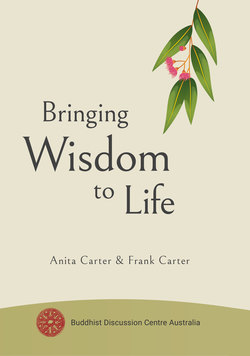Читать книгу Bringing Wisdom to Life - Anita Carter - Страница 4
На сайте Литреса книга снята с продажи.
Chapter 1 – The Happiness You Are Looking For
ОглавлениеThere are many ways of explaining Buddhism. Sometimes it is said it is not a religion, it is a philosophy or a way of living. Whatever label it has is less important than how it can help us.
Buddhism is a way of living and self-training which develops and refines our disposition, our attitudes, our behaviour and cultivates our mind on a path that produces deep personal happiness and well being.
Buddhism enables us to turn our lives into an unfolding source of inner understanding or insight of ourselves, others and the world we experience.
The teachings of Buddhism are based upon the way nature works, the way our mind works naturally. These Teachings arise from The Buddha's perfectly clear observation and insight into the mind and into the processes of life.
The Buddha simply saw things perfectly clearly. That was the quality of his attainment as a Buddha. This is what is generally referred to as enlightenment. His incomparable Buddha mind was sublime wisdom itself, and the origin of what became the religion Buddhism.
There were 56 religions in The Buddha's time. Why did he start another one?
The Buddha saw what no one else at his time could see. What none of the other religions at that time or since have offered humanity. He saw the truth about the actual nature of the mind and body - the nature of the different types of consciousness we can experience, the nature of thought, perception, memory, the nature of feeling, the natural laws which govern our minds functions and, the truth about the elusive nature of what we call our "self".
And in recognising this nature of mind he also discovered a particular awareness, unseen by everyone in the noise of our mental phenomena, a unique, already-liberated state which has no mental pain whatever. It is described as perfect peace and it is named nirvana in Sanskrit, or nibbana in the Pali language used in the Buddha's time.
The Buddha, having discovered the existence of an unconditioned state, that he called nibbana, spent the next forty-five years of his life teaching countless others the path or practice through which nibbana could be known each for himself or herself. It is a naturally existing state that is the goal of Buddhist practice.
So many persons in our modern cultures who are not socially isolated, are well educated, and have affluent lifestyles frequently experience many forms of unhappiness. These include worry, stress, anxiety, insecurity, sadness, anger, frustration and depression.
Australia, for example, has one of the world's highest rates of suicide, particularly among our youth, yet our biggest cities are regarded as being among the top ten cities in the world to reside in. Our material standards of living are among the world’s best. Yet our mental culture appears, by this criterion, to be nothing special.
Buddhism provides the mental technology, the mind tools and methods we need to see our own mind with increasing clarity and understanding. This is the Buddhist approach to developing and maintaining a healthy mind and a good life.
Whilst we may read about Buddhism, it is not enough for us to have an intellectual understanding or even respectful appreciation of what the Buddha found out. Just as looking at food on the table cannot cure us of hunger, merely appreciating Buddhist Teachings will not make us happy.
As such Buddhism is sometimes referred to as a do-it-yourself religion because we need to apply the Buddha’s advice in our own life to experience any significant benefit.
So where do we start?
As we read or hear about Buddhism we need an active intention to find something worthwhile to apply in our life. And then we do apply it. We want to apply the instructions in the same way as if we have visited the doctor and then we go straight to the chemist so we can take the medicine quickly.
What usually happens is we forget ninety percent or more of what we read within a few days. If we forget ninety percent in a few days why bother? Applying ten percent of what was heard will not work. It's an approach which is likely to result in only a very weak improvement. Then we may tell others "Oh, I tried that but it doesn’t work".
Active listening and reading is the opposite of passive listening and reading. Passive reading can be considered as reading to "know" or find out about Buddhism through collecting information about Buddhism without any implementing any action steps, that is; without changing anything we do. That’s how we have often learnt things in our past. However, we won’t understand much about ourselves from listening to the Teachings of the Buddha (Buddha Dhamma) that way. What we hear must be translated into action.
At the time we discover something new our mind has the best understanding of why we need to change our habit and adopt the new behaviour. The next day our sense of urgency to change becomes weaker, the day after less again. We are creatures of habit; our habit energy is often difficult to overcome. Our best opportunity to make a change, the best conditions to make a change is generally as soon as we understand clearly the need to change.
If we keep doing what we've always done, we'll get the same results.
